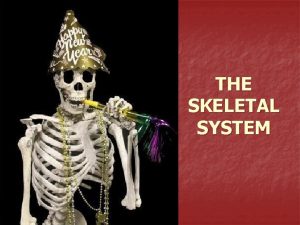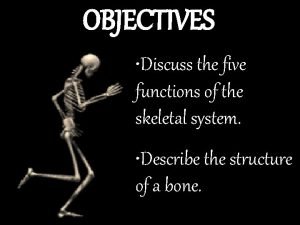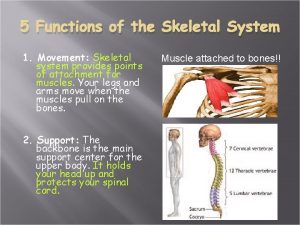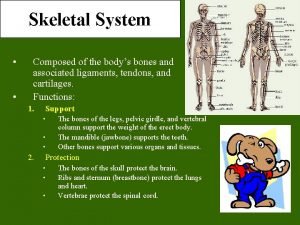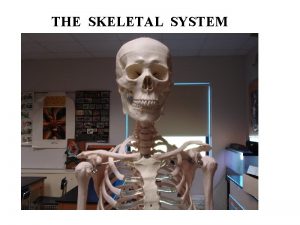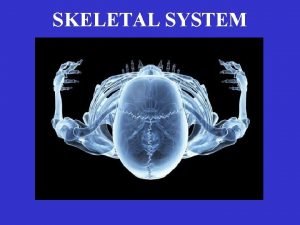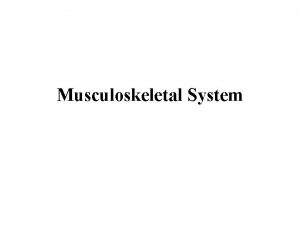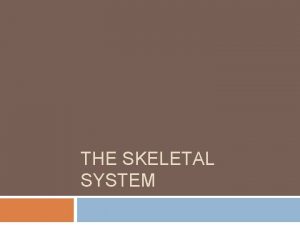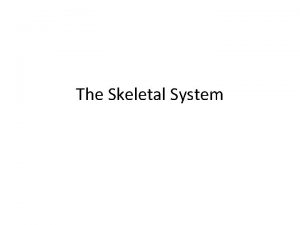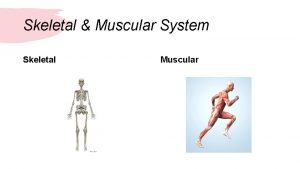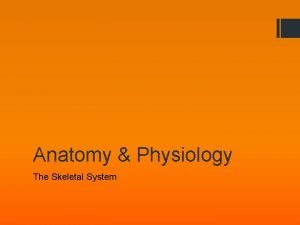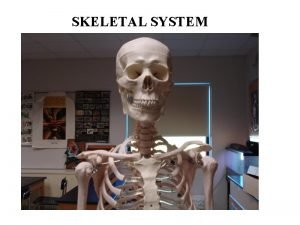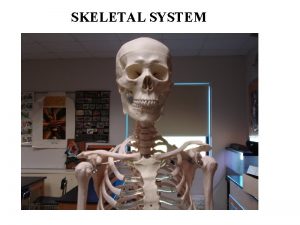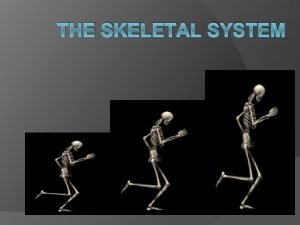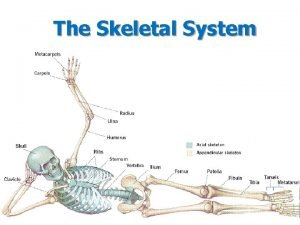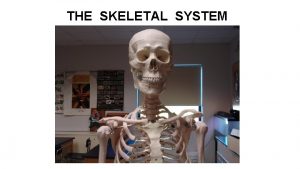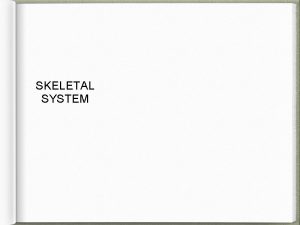THE SKELETAL SYSTEM Functions of Skeletal System SUPPORT






































- Slides: 38

THE SKELETAL SYSTEM

Functions of Skeletal System • SUPPORT: Hard framework that supports and anchors the soft organs of the body. • PROTECTION: Surrounds organs such as the brain and spinal cord. • MOVEMENT: Allows for muscle attachment therefore the bones are used as levers. • STORAGE: Minerals and lipids are stored within bone material. • BLOOD CELL FORMATION: The bone marrow is responsible for blood cell production.

Bones • Periosteum-tough membrane surrounding bone for protection, bone growth and muscle attachment • Spongy bone – found at ends of bones. More loosely packed cells

Compact bone • Hard, dense material beneath periosteum • Contains bone cells called osteocytes • Non-living matrix surrounds osteocytes – Collagen–protein for strength – Calcium phosphate and calcium carbonate for hardness Haversian canals – opening for blood vessels

Connective Tissues 1. Cartilage Flexible supportive tissue - ear & nose Cushions and protects ends of bones (arthritis)

2. Ligament Connects bone to bone Deep inside joint Lateral Collateral Ligament Medial Collateral Ligament (MCL) Posterior Cruciate Ligament (PCL) Anterior Cruciate Ligament (ACL)

3. Tendon connects bone to muscle outside the joint

Joints – 2 bones come together. Held together by ligaments. Cushioned by cartilage. Lubricated by synovial fluid • Types of joints: – Ball-and-socket shoulder & hip

Hinge – knee & elbow

Gliding – vertebrae & wrist

Saddle - thumb

Immovable (suture) - skull





Frontal View

Mandible Frontal View

Clavicle

Scapula

Costals (Ribs)

Sternum

Vertebrae 1. Cervical (7) 2. Thoracic (12) 3. Lumbar (5)

Humerus

Ulna

Radius (thumb side)

Clavicle Scapula Sternum Costals (Ribs) Humerus Ulna Vertebra Radius

Sacrum

Ilium

Ischium

Pubis

Femur

Patella

Tibia

Fibula

Ilium Ischium Sacrum Pubis Femur Patella Fibula Tibia

Phalanges Metacarpals Carpals Bones of the Hand

Phalanges Metatarsals Tarsals Bones of the Foot
 What are the five functions of the skeletal system
What are the five functions of the skeletal system What are the five functions of the skeletal system?
What are the five functions of the skeletal system? 5 functions of a skeletal system
5 functions of a skeletal system Coccyx meaning
Coccyx meaning 5 function of skeletal system
5 function of skeletal system Functions of the skeletal system
Functions of the skeletal system Functions of skeletal muscle
Functions of skeletal muscle Example of major points
Example of major points Hát kết hợp bộ gõ cơ thể
Hát kết hợp bộ gõ cơ thể Lp html
Lp html Bổ thể
Bổ thể Tỉ lệ cơ thể trẻ em
Tỉ lệ cơ thể trẻ em Voi kéo gỗ như thế nào
Voi kéo gỗ như thế nào Tư thế worm breton
Tư thế worm breton Alleluia hat len nguoi oi
Alleluia hat len nguoi oi Các môn thể thao bắt đầu bằng từ đua
Các môn thể thao bắt đầu bằng từ đua Thế nào là hệ số cao nhất
Thế nào là hệ số cao nhất Các châu lục và đại dương trên thế giới
Các châu lục và đại dương trên thế giới Công thức tiính động năng
Công thức tiính động năng Trời xanh đây là của chúng ta thể thơ
Trời xanh đây là của chúng ta thể thơ Mật thư tọa độ 5x5
Mật thư tọa độ 5x5 Làm thế nào để 102-1=99
Làm thế nào để 102-1=99 Phản ứng thế ankan
Phản ứng thế ankan Các châu lục và đại dương trên thế giới
Các châu lục và đại dương trên thế giới Thơ thất ngôn tứ tuyệt đường luật
Thơ thất ngôn tứ tuyệt đường luật Quá trình desamine hóa có thể tạo ra
Quá trình desamine hóa có thể tạo ra Một số thể thơ truyền thống
Một số thể thơ truyền thống Cái miệng nó xinh thế chỉ nói điều hay thôi
Cái miệng nó xinh thế chỉ nói điều hay thôi Vẽ hình chiếu vuông góc của vật thể sau
Vẽ hình chiếu vuông góc của vật thể sau Thế nào là sự mỏi cơ
Thế nào là sự mỏi cơ đặc điểm cơ thể của người tối cổ
đặc điểm cơ thể của người tối cổ Thứ tự các dấu thăng giáng ở hóa biểu
Thứ tự các dấu thăng giáng ở hóa biểu Vẽ hình chiếu đứng bằng cạnh của vật thể
Vẽ hình chiếu đứng bằng cạnh của vật thể Fecboak
Fecboak Thẻ vin
Thẻ vin đại từ thay thế
đại từ thay thế điện thế nghỉ
điện thế nghỉ Tư thế ngồi viết
Tư thế ngồi viết Diễn thế sinh thái là
Diễn thế sinh thái là
